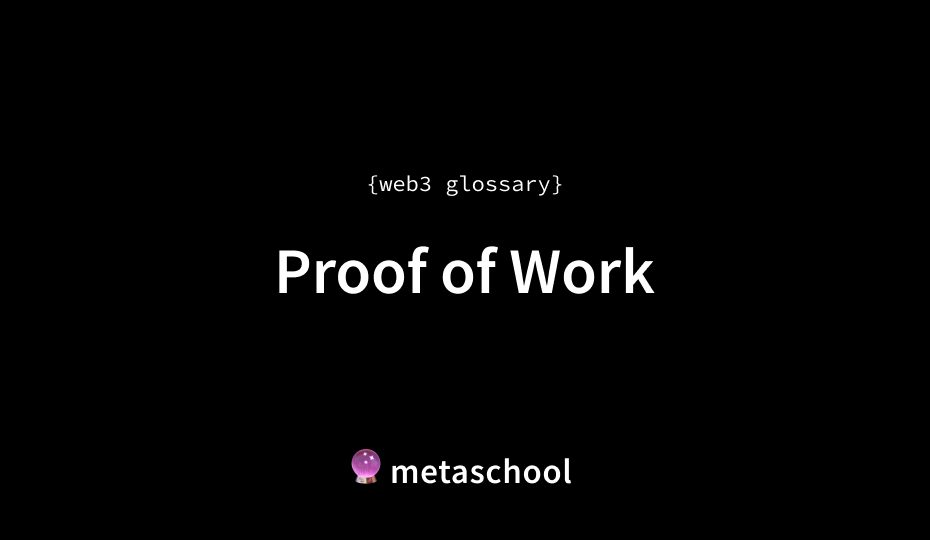Table of Contents
What is Proof of Work? 📖
Proof of work (PoW) is a type of algorithm used by some cryptocurrencies to achieve distributed consensus. It is the most widely-used algorithm in the cryptocurrency space, and is used by cryptocurrencies such as Bitcoin, Litecoin, and Monero.
The idea for Proof of work was first introduced by Cynthia Dwork and Moni Naor in 1993. It was later applied to Bitcoin in 2009 by Satoshi Nakamoto. POW was also used by Ethereum 1.0 before shifting towards Proof of Stake (POS) for Ethereum 2.0 during the long awaited Merge of September 2022.
In a PoW-based system, the creator of a new block (i.e., a miner) is chosen based on their ability to solve a computationally difficult problem. This involves performing a large number of calculations, which require a significant amount of energy to complete. The miner who is able to solve the problem first is rewarded with a certain number of units of the cryptocurrency, as well as any transaction fees that are included in the block.
The purpose of this process is to ensure that new blocks are added to the blockchain in a secure and trustworthy way. Because the problem that miners are trying to solve is difficult to compute, it is unlikely that an attacker would be able to create a longer chain of blocks than the legitimate blockchain, even if they control a large amount of computing power. This makes PoW-based systems highly resistant to attacks, such as the double-spending of cryptocurrency.
PoW: Advantages ✅
One of the main advantages of proof of work is that it is highly secure. Because it requires a significant amount of computing power to create new blocks, it is difficult for an attacker to launch a successful attack on the network. This means that users can trust that their transactions will be processed and recorded on the blockchain in a secure and reliable way.
Another advantage of proof of work is that it is decentralized. Because anyone with the necessary hardware and software can become a miner and compete to create new blocks, the power to create new blocks is distributed among a large number of users. This means that no single entity has control over the network, which helps to prevent censorship and ensure that the network remains open and accessible to all.
Proof of Work has a nice property that it can relay through untrusted middlemen. We don’t have to worry about the chain of custody of communication. It does not matter who tells you the longest chain, the proof of work speaks for itself.
Satoshi Nakamoto, founder Bitcoin
PoW: Challenges ❌
One of the main challenges with PoW is that it is highly energy-intensive. Because miners need to perform a large number of calculations in order to create new blocks, PoW-based systems require a significant amount of electricity to operate. This can make them expensive and unsustainable in the long term.
Another challenge with PoW is that it can lead to centralization. Because mining requires a significant amount of computing power, the mining process is dominated by a small number of large mining pools, which are able to amass a large amount of computing power. This can make the network more vulnerable to attacks, as a small number of entities control the majority of the mining power.
In response to these challenges, some cryptocurrencies have started to use alternative algorithms, such as proof of stake (PoS), which are less energy-intensive and less susceptible to centralization. However, PoW remains the most widely-used algorithm in the cryptocurrency space, and is likely to continue to be used by a large number of cryptocurrencies in the future.
How does it work?
Once a transaction occurs in the blockchain it goes through some checkpoints to verify and validate this transaction. In the chain, each block of the transaction contains a specific hash.
Proof of Work uses algorithms that generate a hash for blocks. The algorithm that Bitcoin uses is known as the Secure Hash Algorithm (SHA)-256. It contains unique hashes with 64 characters and is readily used for cryptographic security.
For these block transactions to be confirmed and added to the blockchain, miners have to generate a hash equal to the hash generated by SHA-256. Then miners compete with each other to find this hash and whoever gets the hash right is rewarded some amount of crypto.
With that, they also gets the chance to add a new block to the blockchain. It should be noted, though, that it’s not easy to do so – the whole process requires a lot of processing and computational power. Moreover, finding the hash, itself, is difficult but an effective enough mechanism to prevent any kind of manipulation of the transactions.
Here’s how Proof of Stake performs vs Proof of Work
To tackle the aforementioned problems, some blockchains notably Ethereum, have shifted to the Proof of Stake (POS) consensus mechanism during the Merge.
| Proof of Work (POW) | Proof of Stake (POS) |
| Participating nodes referred to as miners | Participating nodes referred to as validators |
| Computational power determines mining capacity | Stake in the network determines validating capacity |
| Mining forms coins, miners get block rewards | No new coins formed, validators receive transaction fees |
| More prone to 51% attacks | Zero chances of 51% attacks |
| Super high energy consumption | Low energy consumption |
Examples of cryptocurrencies that use PoW
Bitcoin was the first cryptocurrency to use PoW, and it remains the most widely-used and well-known cryptocurrency in the world.
Litecoin is a fork of Bitcoin that was created in 2011, and it uses a slightly modified version of the PoW algorithm.
Monero is a privacy-focused cryptocurrency that was launched in 2014, and it uses a different type of PoW algorithm that is designed to be more resistant to ASIC mining hardware.
